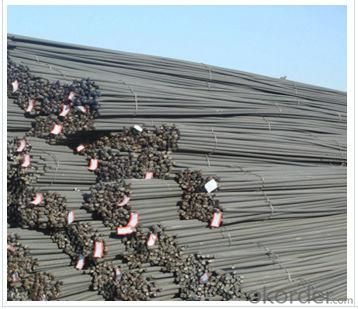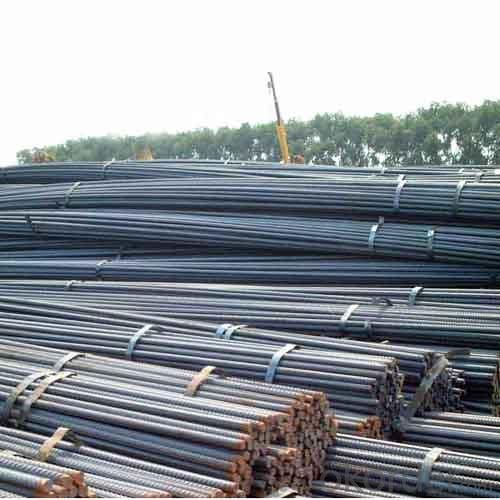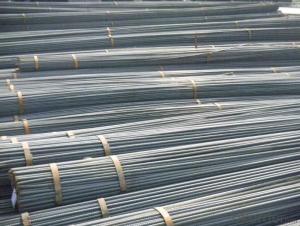Hot rolled deformed steel bar for construction
- Loading Port:
- Tianjin
- Payment Terms:
- TT or LC
- Min Order Qty:
- 25 m.t.
- Supply Capability:
- 100000 m.t./month
OKorder Service Pledge
OKorder Financial Service
You Might Also Like
Product Description:
OKorder is offering hot rolled deformed steel bar for construction at great prices with worldwide shipping. Our supplier is a world-class manufacturer of steel, with our products utilized the world over. OKorder annually supplies products to European, North American and Asian markets. We provide quotations within 24 hours of receiving an inquiry and guarantee competitive prices.
Product Applications:
Hot rolled deformed steel bar for construction are ideal for structural applications and are widely used in the construction of buildings and bridges, and the manufacturing, petrochemical, and transportation industries.
Product Advantages:
OKorder's deformed steel bar are durable, strong, and resist corrosion.
Main Product Features:
· Premium quality
· Prompt delivery & seaworthy packing (30 days after receiving deposit)
· Corrosion resistance
· Can be recycled and reused
· Mill test certification
· Professional Service
· Competitive pricing
Product Specifications:
Deformed bar is widely used in buildings, bridges, roads and other engineering construction. Big to highways, railways, bridges, culverts, tunnels, public facilities such as flood control, dam, small to housing construction, beam, column, wall and the foundation of the plate, deformed bar is an integral structure material. With the development of world economy and the vigorous development of infrastructure construction, real estate, the demand for deformed bar will be larger and larger..
Packaging & Delivery of HRB400 Deformed Steel Bar:
Packaging Detail: products are packed in bundle and then shipped by container or bulk vessel, deformed bar is usually naked strapping delivery, when storing, please pay attention to moisture proof. The performance of rust will produce adverse effect.
Each bundle weight: 2-3MT, or as required
Payment term: TT or L/C
Delivery Detail: within 45 days after received advanced payment or LC.
Label: to be specified by customer, generally, each bundle has 1-2 labels
Trade terms: FOB, CFR, CIF



FAQ:
Q1: How do we guarantee the quality of our products?
A1: We have established an advanced quality management system which conducts strict quality tests at every step, from raw materials to the final product. At the same time, we provide extensive follow-up service assurances as required.
Q2: Can stainless steel rust?
A2: Stainless does not "rust" as you think of regular steel rusting with a red oxide on the surface that flakes off. If you see red rust it is probably due to some iron particles that have contaminated the surface of the stainless steel and it is these iron particles that are rusting. Look at the source of the rusting and see if you can remove it from the surface.
- Q:How are steel rebars protected from fire damage?
- Steel rebars can be safeguarded against fire damage using a variety of techniques. One commonly employed approach involves applying fire-resistant coatings to the rebars. These coatings are specifically formulated to endure high temperatures and prevent the steel from reaching its critical temperature, at which point its structural integrity would be compromised. Another method involves encasing the rebars in fire-resistant concrete. This specially designed concrete acts as a shield, impeding the direct transfer of heat to the steel rebars and thus safeguarding them from fire damage. Additionally, temporary protection for steel rebars during construction can be provided by using fire-resistant wraps or blankets. These wraps are crafted from materials that are resistant to fire and are directly applied to the rebars, creating a barrier that prevents direct exposure to fire. It is crucial to note that the level of fire protection necessary for steel rebars is contingent upon the specific building codes and regulations in place. These codes typically stipulate the minimum fire resistance rating that must be attained for structural elements, including rebars, in order to guarantee the safety of the building and its occupants.
- Q:Are steel rebars fire resistant?
- Steel rebars are generally considered to possess fire resistance. Steel, as a material, cannot burn or contribute to the spread of fire because it is incombustible. When exposed to fire, steel rebars can endure high temperatures for a prolonged duration without compromising their structural integrity. This ability is attributed to the high melting point of steel, which stands at approximately 1370 degrees Celsius (2500 degrees Fahrenheit). Moreover, during construction, steel rebars are often encased in concrete, which adds an extra layer of protection against fire. However, it is important to note that under extremely intense and long-lasting fire conditions, steel may gradually weaken and lose its ability to bear loads. Hence, fire protection measures like the application of fire-resistant coatings or fireproofing materials are sometimes implemented to further enhance the fire resistance of steel structures.
- Q:Can steel rebars be used in industrial plant construction?
- Yes, steel rebars can be used in industrial plant construction. Steel rebars are commonly used in reinforced concrete structures, including industrial plants, to provide structural stability and strength. They enhance the overall durability and load-bearing capacity of the construction, making them suitable for industrial applications.
- Q:How are steel rebars transported and stored on construction sites?
- Steel rebars are typically transported to construction sites using trucks or trailers. These vehicles are designed to safely carry and unload the heavy and bulky rebars. Upon arrival at the site, the rebars are usually offloaded using cranes or forklifts. To ensure efficient storage and easy access, rebars are often stored in designated areas called rebar yards. These yards are typically organized in a way that allows for easy identification and retrieval of rebars when needed. The rebars are sorted and stacked according to their size, length, and type to prevent any confusion during construction. In the rebar yard, rebars are commonly stored horizontally on steel or wooden racks. The racks are designed to provide proper support and prevent damage to the rebars. It is important to note that rebars should be stored above ground level to protect them from moisture, rust, and contamination. They should also be kept away from any damp areas or direct contact with soil. To maintain the quality of the rebars, it is crucial to protect them from exposure to rain, snow, and excessive sunlight. Therefore, construction sites often use protective covers, such as tarps or plastic sheets, to shield the rebars and prevent any corrosion or deterioration. Additionally, construction workers must handle rebars with care to avoid any bending or deformation. Special attention should be given to prevent rebars from being dropped or dragged, as it can compromise their structural integrity. Overall, the transportation and storage of steel rebars on construction sites require careful planning and adherence to safety guidelines to ensure their quality and effectiveness in reinforcing concrete structures.
- Q:Are there any specific guidelines for storing and handling steel rebars?
- Specific guidelines exist for the storage and handling of steel rebars. Take note of the following essential points: 1. Storage: To prevent corrosion, it is necessary to store steel rebars in an area that is clean, dry, and well-ventilated. Place them on timber or other suitable materials to keep them elevated and away from moisture. 2. Handling: Exercise caution when handling steel rebars to avoid any damage or bending. It is advised to use appropriate equipment like cranes, forklifts, or sturdy hooks for lifting and moving rebars. Dragging or dropping them should be avoided as it may cause deformations and compromise their structural integrity. 3. Bundling: Properly bundle and secure rebars together using steel wires or straps to prevent rolling or shifting during storage or transportation. This ensures stability and reduces the risk of accidents. 4. Separation: Keep different sizes and types of rebars separate and clearly labeled to prevent confusion during construction. This facilitates easy identification and utilization of the required rebar according to the structural plans. 5. Protection: Guard rebars against exposure to moisture, rain, snow, and other weather elements. When storing rebars outdoors, utilize waterproof covers or tarps to shield them and prevent the formation of rust. 6. Inspection: Regular inspections should be conducted to identify signs of corrosion, damage, or bending. Any defective or compromised rebars must be promptly removed and replaced to maintain the structural integrity of the construction project. 7. Transportation: During transportation, ensure that rebars are securely fastened and loaded onto appropriate vehicles to prevent movement or falling off. Employ sufficient padding and tie-downs to protect rebars from damage and ensure safe transportation. Adhering to these guidelines is crucial in upholding the quality, durability, and safety of steel rebars throughout their storage and handling process.
- Q:What is the lifespan of steel rebars?
- The longevity of steel rebars can differ based on various elements including the steel's quality, environmental circumstances, and maintenance methods. In general, steel rebars possess an extensive lifespan and are specifically engineered to provide structural reinforcement for numerous years. When properly installed and maintained, steel rebars can endure for several decades or even surpass a century. Nevertheless, factors such as exposure to corrosive surroundings or inadequate maintenance can considerably diminish their lifespan. Routine examinations, protective coatings, and appropriate drainage systems can aid in prolonging the lifespan of steel rebars and guaranteeing their long-lasting durability.
- Q:What is the role of steel rebars in reducing concrete shrinkage?
- The reinforcement and added strength provided by steel rebars are crucial in minimizing concrete shrinkage. When concrete cures, it goes through hydration, a process in which it loses water and shrinks. This shrinkage has the potential to cause cracking and structural instability. By incorporating steel rebars into the concrete, they serve as reinforcement and help counteract shrinkage. These rebars offer tensile strength, which means they can resist pulling or stretching forces. As the concrete shrinks, the rebars hold it together and prevent excessive cracking. Moreover, steel rebars aid in distributing the load more evenly throughout the concrete structure. This reduces stress concentration in specific areas and further reduces the likelihood of shrinkage-related cracking. Additionally, steel rebars can act as thermal conductors, promoting even heat dissipation within the concrete. This prevents temperature differences within the structure, which can lead to differential shrinkage and subsequent cracking. To summarize, steel rebars play a vital role in reducing concrete shrinkage by providing reinforcement, resisting tensile forces, distributing loads, and regulating temperature differences. Consequently, they enhance the overall durability and stability of the concrete structure, minimizing the adverse effects of shrinkage.
- Q:Are steel rebars susceptible to corrosion?
- Yes, steel rebars are susceptible to corrosion. Corrosion is a natural process that occurs when steel is exposed to moisture, oxygen, and other environmental factors. When steel rebars are used in concrete structures, they are exposed to the elements and can come in contact with water or moisture, which can lead to the formation of rust. This rust can weaken the rebars and eventually compromise the structural integrity of the concrete. To prevent corrosion, various protective measures can be taken, such as applying a protective coating or using corrosion-resistant steel rebars. Regular maintenance and inspection of the concrete structures are also crucial to detect and address any signs of corrosion in a timely manner.
- Q:What is the effect of steel rebars on the weight of a structure?
- Steel rebars have a notable impact on the weight of a structure. Typically composed of steel, these reinforcement bars possess a high strength-to-weight ratio. When integrated into a structure, they bestow strength and rigidity without significantly augmenting the overall weight. By reinforcing concrete with steel rebars, the structure becomes more capable of withstanding diverse forces and stresses, including tension, compression, bending, and shearing. This reinforcement empowers the structure to bear heavier loads and elevates its durability and longevity. While steel rebars confer strength to the structure, they do not make a considerable contribution to its weight. Consequently, this is advantageous as it facilitates the construction of lighter and more efficient structures. The reduced weight presents several benefits, such as lower construction expenses, diminished material requirements, decreased transportation costs, and improved seismic performance. Furthermore, the utilization of steel rebars also permits the construction of slimmer and visually pleasing structures. The heightened strength provided by the rebars allows for the employment of thinner concrete sections, leading to sleek designs and more open spaces. In conclusion, the effect of steel rebars on the weight of a structure is minimal. Instead, their principal role lies in enhancing the structural integrity, strength, and durability of the edifice without burdening it with excessive weight.
- Q:How do steel rebars affect the overall corrosion resistance of marine structures?
- The overall corrosion resistance of marine structures is significantly affected by steel rebars. Depending on various factors, the presence of steel rebars in concrete marine structures can either enhance or deteriorate their resistance to corrosion. To begin with, when appropriate preventive measures are taken, steel rebars can enhance corrosion resistance. For example, if the rebars are adequately coated with anti-corrosion materials like epoxy or zinc, they can provide an additional layer of protection against the corrosive effects of seawater. Moreover, ensuring proper concrete cover and compaction during construction can help prevent seawater from penetrating the rebars, reducing the risk of corrosion. Conversely, if steel rebars are not properly coated or if the concrete cover is insufficient, they can contribute to the degradation of marine structures. When exposed to the aggressive marine environment, rebars can corrode, leading to rust formation. Rust occupies more space than steel, causing expansion that exerts pressure on the surrounding concrete. This pressure can result in concrete cracking and spalling, further exposing the rebars to corrosion and compromising the overall structural integrity of the marine structure. Regular maintenance and inspection are crucial to mitigate the negative effects of steel rebars on corrosion resistance. Periodic inspections can help identify any signs of corrosion, enabling timely repairs or replacement of rebars. Additionally, implementing cathodic protection systems can provide an electrochemical countermeasure against corrosion, ensuring the longevity and durability of the marine structure. In conclusion, steel rebars play a vital role in the corrosion resistance of marine structures. Proper coating, concrete cover, and maintenance measures are essential to ensure the positive contribution of rebars to corrosion resistance. Neglecting these factors can lead to the degradation of marine structures.
1. Manufacturer Overview |
|
|---|---|
| Location | |
| Year Established | |
| Annual Output Value | |
| Main Markets | |
| Company Certifications | |
2. Manufacturer Certificates |
|
|---|---|
| a) Certification Name | |
| Range | |
| Reference | |
| Validity Period | |
3. Manufacturer Capability |
|
|---|---|
| a)Trade Capacity | |
| Nearest Port | |
| Export Percentage | |
| No.of Employees in Trade Department | |
| Language Spoken: | |
| b)Factory Information | |
| Factory Size: | |
| No. of Production Lines | |
| Contract Manufacturing | |
| Product Price Range | |
Send your message to us
Hot rolled deformed steel bar for construction
- Loading Port:
- Tianjin
- Payment Terms:
- TT or LC
- Min Order Qty:
- 25 m.t.
- Supply Capability:
- 100000 m.t./month
OKorder Service Pledge
OKorder Financial Service
Similar products
New products
Hot products
Related keywords





























